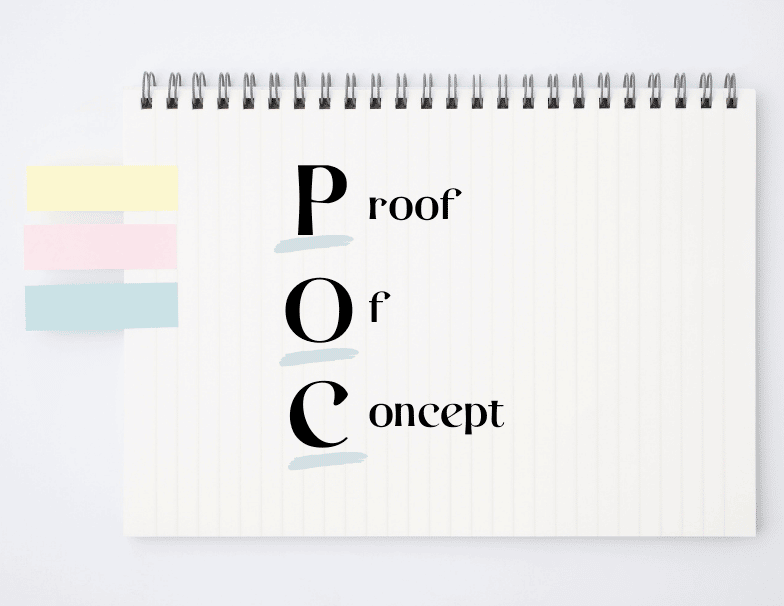Product development projects cannot move forward without evidence that a viable product can be created. This is why a proof of concept (POC) is necessary, proving that a business idea, product or project has a solid foundation on which to start working.
Regardless of the industry, a proof of concept will help you assess whether your concept – be it a product, idea or design – is profitable and has the potential for real-world application.
In this article we explain what a proof of concept is, the steps involved in carrying it out and the differences between proof of concept, prototype and minimum viable product.
What is proof of concept (POC)?
Proof of concept (POC) is a fundamental part of the design process. It is an initial test of an idea, method or product in order to show its potential and feasibility in the real world.
It takes place during the ideation phase of a project, before design and engineering work begins, and usually consists of a small and relatively simple or undeveloped version of the product.
The purpose of a proof of concept is to validate assumptions and illustrate that a new product or idea could be successful. In this sense, members of the product development and design team also use proof of concept as a tangible way to identify any unforeseen risks in the production or execution of the product or idea.
Proof of concept (POC) is an excellent method to determine the feasibility of a concept before it is implemented.
However, the POC does not demonstrate the shape of the final design, but only represents limited functionalities of the product.
Proof of concept at an early stage allows:
- Identify potential risks and obstacles.
- Determine the feasibility of the project.
- Provide clear evidence of functionality to stakeholders before investing.
Ultimately, proof of concept is fundamental in the product development process because it is the basis for the prototype and the minimum viable product.
Proof of concept: Different from prototype and minimum viable product
Proof of concept versus prototype
A proof of concept may appear similar to a prototype, however, its objectives are very different. Although often confused, it is not a prototype because it does not contain all the design requirements.
A prototype is a real working model of a project that shows exactly how the product will work in terms of mechanics, design, user experience, etc.
While a proof of concept tests the feasibility of a new idea, the prototype shows exactly how the idea can be realised.
Proof of Concept versus Minimum Viable Product
Although they have some things in common, proof of concept and Minimum Viable Product differ significantly from each other. The MVP refers to a scaled-down version of a new product with only basic features to test it with real customers to see if it works in the market.
Therefore, the proof of concept and the Minimum Viable Product are not only at different stages of the product development process, but also serve completely different purposes.
Phases of the proof of concept
From the development of the idea to its realisation and presentation to investors, the proof of concept can be divided into 5 basic steps.
1. Demonstrating the need for the product
When presenting the POC, the need for the product must be established by mentioning who the target market is and what are their pain points or situations that customers may encounter.
In this regard, it will be necessary to interview a sample of customers or panellists to understand and verify their needs and those of the product.
2. Solution ideation
Based on the responses from the sample group, the product development team can start brainstorming to find appropriate solutions to the customers’ pain points, bearing in mind that they must also be feasible and within the project’s capabilities.
3. Evaluation of ideas
Next, the team should evaluate each of the proposed solutions in terms of likely costs, timelines, technologies needed, operational capacity required, competition, resources and other factors. So that they are able to narrow down the list of ideas to the most feasible and finalise their product proposal.
4. Design a proof of concept.
With feedback from potential users, create a proof of concept of the product that addresses the pain points and offers feasible solutions.
Similarly, it is interesting to have customers test the proof of concept and provide feedback so that the product idea can be refined based on the feedback.
Use the feedback from your potential users to refine the proof of concept.
5. Presentation of the proof of concept.
This should clarify, among other things, the problems solved by the product, the features addressed by these solutions and the technologies integrated in its development to demonstrate the feasibility of the project idea.
Similarly, it is necessary to detail the product development components, including clearly defined success criteria, functionalities, features and benefits of the product. It is also necessary to include details such as schedule, cost, success criteria and resources required.
The finalised proof of concept will then be presented to stakeholders and investors for their approval, certifying its viability and finally approving the product for development.
At Infinitia we have the best experts in strategic design, engineering and innovation. Contact our product development team and tell us about your idea.





